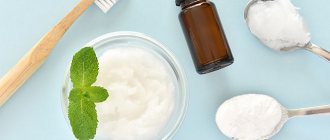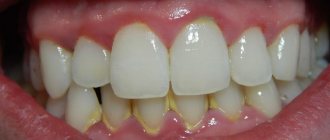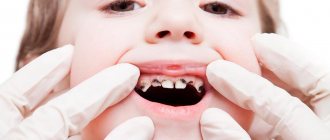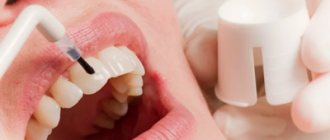Author of the article:
Soldatova Lyudmila Nikolaevna
Candidate of Medical Sciences, Professor of the Department of Clinical Dentistry of the St. Petersburg Medical and Social Institute, Chief Physician of the Alfa-Dent Dental Clinic, St. Petersburg
Coconut oil is a popular folk remedy for teeth whitening. But it is worth remembering that all such miracle remedies have a rather modest effect, like banana peels. Therefore, if you want to achieve real results, it is better to contact your dentist and choose one of the in-office or professional home whitening methods, for example, photo whitening, laser and others. In addition, you can use specialized pastes that will ensure safe and effective lightening of surface enamel pigmentation.
Coconut oil is more suitable for light prevention and disinfection of the oral cavity. The most common practice of using this product involves its resorption. The procedure is very simple: you need to place a small amount of oil in your mouth and “rinse” your mouth with it, as if it were a regular mouthwash. This method was used by the ancient Hindus more than a thousand years ago, and to this day it is widespread in India.
You need to keep the oil in your mouth for at least 20 minutes, and then spit it out. This will reduce the amount of harmful bacteria in your mouth, preventing tooth decay and other problems.
The fact is that in our mouths there are a large number of different bacteria that create a biological film on the teeth - dental plaque. A small amount of it is quite normal, but if the substance becomes too much, gingivitis, an unpleasant odor, and inflammation of the gums may appear. At the same time, the teeth become more and more saturated yellow.
Why choose coconut oil?
For such purposes, you can use a variety of oils, for example, lemon, tea tree, sesame or even sunflower oil. But coconut oil has a number of additional beneficial properties and a rather pleasant taste. This oil contains lauric acid, which has antimicrobial properties. The substance prevents the spread of viruses, pathogenic bacteria and fungi.
At the same time, doctors advise not to get carried away with folk remedies, but to use special mouth rinses, which have a more pronounced antiseptic effect, help relieve inflammation and reduce pain.
Natural alternative to toothpaste
In a study evaluating the biocidal properties of coconut oil against tooth decay-causing bacteria, the oil was found to be effective.
The effects of coconut oil were tested in its natural state and after being treated with enzymes, a process similar to digestion. The oils have been tested against strains of Streptococcus bacteria, common inhabitants of the oral cavity.
Enzyme-modified coconut oil has been found to seriously inhibit the growth of most strains of Streptococcus bacteria, including Streptococcus mutans, an acid-forming bacterium that is a leading cause of tooth decay. It is believed that enzymes' breakdown of fatty coconut oil turns it into acids that are toxic to some bacteria.
As Dr Damien Brady, Principal Investigator, notes:
“Adding enzyme-modified coconut oil to dental hygiene products may be an attractive alternative to chemical additives, especially since it is effective at relatively low concentrations. Additionally, with the increase in antibiotic resistance, it is important to look at new ways to combat microbial infection."
Properties of coconut oil
Many ailments begin their journey in our body from the oral cavity, since this is where the optimal conditions are for the proliferation of bacteria and viruses. They enter the bloodstream through the gums and other areas of the mucous membrane. In addition, pathogenic microbes penetrate the teeth, destroying enamel and dentin. Bacteria enter the stomach with saliva and food.
At the same time, brushing your teeth allows you to get rid of about 10% of pathogens if you brush with regular store-bought toothpaste. You can enhance its effect with coconut oil, which not only helps to better clean the oral cavity, but also improves the health of teeth and gums, increasing their protection.
- Regularly rinsing your mouth with coconut oil will help strengthen your entire immune system, reducing the likelihood of bronchitis, migraines, sinusitis and other diseases.
- In addition, coconut oil relieves bad breath, inflammation of the gums, and reduces the likelihood of the formation of tartar and ulcers on the mucous membrane. The oil also reduces tooth sensitivity.
- Coconut oil promotes good absorption of various minerals by the body: magnesium, calcium, etc.
It is worth remembering that no matter how large a range of beneficial properties the oil has, specialized dental products are much more effective.
When the enamel becomes lighter
Healthy and beautiful teeth give confidence and help make a good impression on others. You can achieve white teeth at home or professionally. In-office teeth whitening is more effective. The result comes quickly. Both hardware and chemical clarification are carried out. The first method is more popular. The catalyst is a special lamp with different types of radiation, for example, laser and ultraviolet. When heated, the whitening gel penetrates well into the dentin. In one visit to the dentist, you can lighten the enamel by 5–8 tones.
Using coconut oil will allow you to see the first improvements in 15-20 days: inflammation of the gum tissue will go away, your breath will become fresh, and the crowns will gradually lighten. The procedure protects the enamel from destruction. The use of special remineralizing agents will strengthen the crowns and prolong their functioning. The basic principles of optimizing dental health include:
- Using toothpastes recommended by your dentist;
- Minimum consumption of baked goods and sugar;
- Reducing daily fructose intake;
- Eliminating processed foods;
- Including whole fresh foods and seasonal vegetables in the diet;
- Maintaining proper oral hygiene;
- Regular visits to the dentist.
Ways to Use Coconut Oil for Teeth Whitening
The most popular way is as follows:
- take a tablespoon of oil;
- rinse your mouth with it for about 15 - 20 minutes;
- Once you're done, spit out the oil and brush your teeth.
Important:
- Never swallow the oil after the procedure, as it accumulates harmful bacteria that must be removed from the body.
- If the procedure is carried out correctly, the oil should turn into a light milky liquid.
- If the butter has hardened, chew it first to warm it up.
- It is best to carry out the procedure in the morning on an empty stomach before brushing your teeth, but if this is inconvenient, you can choose any other time.
- Try not just to keep the oil in your mouth, but to intensively rinse the entire cavity with it, pass it through your teeth back and forth.
- After the procedure, it is better to spit the oil into the toilet or trash can; it is very greasy, so it can clog the sink.
- Don't forget to rinse your mouth with water and brush your teeth thoroughly.
Oil pulling: reviews and opinions of doctors
The lack of scientific knowledge about oil pulling caused a skeptical attitude towards it on the part of doctors. Most of them, while allowing the practice of oil pulling as an additional care, also remind patients to maintain routine routines such as brushing twice daily and flossing.
“I'm not aware of any direct risks associated with oil pulling, but using it as a substitute for regular brushing will certainly increase your risk of tooth decay,” says dentist Corbin Brady. “Oil does not remove plaque or reduce bacteria sufficiently.”
Lisa Matriste, a respected dentist from Australia, recommends that those with amalgam fillings avoid oil pulling: “Never rinse your mouth with oil if you have amalgam fillings. The mercury they contain is lipophilic, meaning it is attracted to oils and fats. "Rinsing will draw out the mercury from the fillings, which will then be absorbed into the tissue, inadvertently poisoning your body at a high rate."
When will the effect appear?
The first improvements become noticeable after about two weeks: gum inflammation disappears, breath becomes fresh, teeth gradually become lighter.
Some people think that using coconut oil will help restore tooth enamel, but there is no scientific evidence to support this. The oil is not a source of minerals, but rather helps prevent the enamel from being destroyed. If you want to restore enamel, use the services of dentists or special remineralizing agents.
Possible harm and contraindications
Oil pulling can cause the greatest harm if you do not know how to rinse your mouth with oil correctly or if you use this procedure as a replacement for standard care. It is extremely important to avoid swallowing the oil as it may cause stomach upset or diarrhea. Also, according to the American Dental Association, oil getting into the lungs poses a risk of developing lipoid pneumonia. It is for this reason that the practice of oil pulling is not recommended for young children. It is worth paying attention to the composition of the oil used, since some of them may contain harmful additives.
When introducing a new hygiene practice into your morning routine, it is important not to overdo it. Rinsing your mouth for more than 20 minutes can cause a variety of side effects, including thirst, dry mouth, and decreased taste sensitivity.
Teeth whitening with coconut oil
In fact, coconut oil cannot significantly lighten teeth as it does not have whitening properties. But it helps eliminate harmful bacteria that cause yellow plaque to appear on teeth, which helps restore the enamel to its natural color. However, it is not a fact that the effect will be the way you want.
It is better to use professional mechanical or ultrasonic teeth cleaning; both of these methods allow you to completely remove soft yellow plaque from your teeth, and ultrasound can also destroy hard deposits - tartar.
Traditional recipe for whitening paste made from coconut oil:
- You will need to mix two tablespoons of coconut oil and the same amount of baking soda to form a paste.
- Add 10 drops of peppermint oil or other essential oil to help improve the smell and taste of the paste.
- When using this paste, carefully monitor the condition of your teeth and gums. Everyone’s body reacts individually; in some cases, tooth sensitivity may increase or irritation on the gums may appear, then the procedure should be stopped.
Oil pulling theory
Oil pulling uses the ability of oil to attract its own kind, namely to pull other oils and fat-soluble toxins from tissues, thereby providing a cleansing effect. Bacteria that inhabit the oral cavity have a greasy outer shell. When they come into contact with another fatty substance, such as oil, they stick or are attracted to it.
Since the oil has the ability to penetrate into hard-to-reach areas of the mouth where a toothbrush cannot reach, it can trap hidden bacteria.
This amazing property of oils has been used for centuries in classical Ayurvedic detox practices. The ancient Indian system of medicine includes the concept of ama, which refers to accumulated toxins and various impurities in the body. Ama is believed to be partially digested material derived from food that clogs the body and causes an immune reaction. It is precisely to reduce this ballast that oil rinsing is aimed.
According to Ayurveda, the tongue is associated with various organs such as the kidneys, heart, lungs, small intestine and spine. Oil pulling is believed to help in eliminating toxic heavy metals through saliva. Oil pulling activates salivary enzymes that absorb toxins and remove them from the body through the tongue.
Here is what the canonical book of Ayurveda, Charaka Samhita, says: “The practice of oil pulling provides strength in the jaw and voice, facial development, maximum taste and pleasure in food. A person who practices it does not suffer from a dry throat, is not afraid of cracked lips, and his teeth are not affected by caries, but become strong. They (teeth) are not painful, are not hypersensitive to sour taste, but gain the ability to chew even the hardest food.”
Clinical researches
A study of the clinical effectiveness of therapeutic and prophylactic products of the Asepta line in the treatment of inflammatory periodontal diseases, carried out in the department of periodontology of the Central Research Institute of Dental Diseases and Maxillofacial Surgery of Rosmedtekhnologii (Moscow), revealed the high effectiveness of the Asepta gum balm and the Asepta mouth rinse for periodontitis. moderate severity. Asepta gum gel also turned out to be effective.
The use of Asepta mouth rinse turned out to be quite effective. In addition, no phenomena of mucosal irritation or brown staining of fillings were recorded. This indicates that the use of this rinse for a two-week period provides an obvious clinical effect in the absence of negative side effects.
Why I don't recommend toothpastes with fluoride
Fluoride has long been declared the answer to the question of the cause of caries, but in recent years it has received especially close attention, and for good reason. A groundbreaking study published in the journal Langmuir found that the supposedly beneficial layer of fluorapatite on teeth is just six nanometers thick.
To get an idea of how thin, imagine a strand of hair—to get its width, you'd need 10,000 of these layers! Scientists are now asking whether this ultra-thin layer can actually protect your enamel and provide any benefit, given the fact that it is quickly eliminated by simple chewing. They write:
“...one must ask whether such narrow...layers can really protect the enamel.”
After all, toothpaste containing cocoa extract theobromine, a natural, naturally occurring substance, is better at restoring and remineralizing exposed dentin (the tissue that forms the bulk of the tooth beneath the enamel) than toothpaste with fluoride, according to one study. Not to mention, fluoride toothpastes are often the largest source of fluoride for young children and a major risk factor for tooth-disfiguring fluorosis. This happens because children swallow large amounts of toothpaste that ends up in their mouths.
Studies have shown that young children often ingest more fluoride from toothpaste than the recommended daily intake from all sources .
Ingesting fluoride, as is the case with fluoridated drinking water, is especially harmful to your health, as science has clearly demonstrated that fluoride is a toxic chemical that accumulates in your tissues over time, harms enzymes, and also leads to a number of serious adverse effects. health consequences, including disruption of neurological and endocrine functions .
Children are particularly at risk of these excess adverse effects. If you have a small child, it is recommended to use fluoride-free toothpastes, although I recommend the same for adults.
Consumer Reviews
SolAlena777 about Asepta Fresh mouth rinse (irecommend.ru)
“Recently, I have been hearing more and more positive reviews about ASEPTA products. So I decided to try something. The ASEPTA FRESH mouth rinse caught my eye...
...I liked the packaging design. Reminds me of a flask. As if the product had just been brought from a chemical laboratory...
...Active components contained in the rinse aid:
- Xylitol and potassium citrate protect tooth enamel and help reduce tooth sensitivity;
- Extracts of sage, chamomile and witch hazel have antimicrobial and anti-inflammatory effects
- Potassium and sodium pyrophosphates prevent the formation of tartar
- Lime and mint provide a pleasant taste and fresh breath
...I really liked that there was no vigor. The mouthwash reminds me of Schweppes carbonated drink, only without the gases and without as much sugar.
I use it 2 times a day, that is, in the morning and in the evening after brushing my teeth with toothpaste. I probably rinse my mouth for at least 20 seconds. To be honest, I try to keep the mouthwash in my mouth longer because I like the taste and I don’t experience any discomfort during use.
For me, a rinse aid is, first of all, protection against plaque throughout the day. I can note that the rinse aid copes with this with a bang. The feeling of clean, plaque-free teeth lasts throughout the day. Maybe this effect weakens a little in the evening, but I like the result...
...I was quite satisfied with the result. Most likely, I will buy ASEPTA FRESH mouth rinse again!”
Sources:
- Study of the clinical effectiveness of treatment and prophylactic agents of the Asepta line in the treatment of inflammatory periodontal diseases (A.I. Grudyanov, I.Yu. Aleksandrovskaya, V.Yu. Korzunina) A.I. GRUDYANOV, Doctor of Medical Sciences, Prof., Head of Department I.Yu. ALEXANDROVSKAYA, Ph.D. V.Yu. KORZUNINA, asp. Department of Periodontology, Central Research Institute of Dentistry and Maxillofacial Surgery, Rosmedtekhnologii, Moscow
- Report on determining/confirming the preventive properties of toothpaste “ASEPTA PLUS” GENTLE WHITENING” Author: doctor-researcher A.A. Leontyev, head Department of Preventive Dentistry, Doctor of Medical Sciences, Professor S.B. Ulitovsky First St. Petersburg State Medical University named after. acad. I.P. Pavlova, Department of Preventive Dentistry
- The role of anti-inflammatory rinse in the treatment of periodontal diseases (L.Yu. Orekhova, A.A. Leontyev, S.B. Ulitovsky) L.Yu. OREKHOVA, Doctor of Medical Sciences, Prof., Head of Department; A.A. LEONTIEV, dentist; S.B. ULITOVSKY, Doctor of Medical Sciences, Prof. Department of Therapeutic Dentistry of St. Petersburg State Medical University named after. acad. I. P. Pavlova
What Science Says
Some people think that oil pulling is unscientific. However, today there are several scientific findings that confirm the positive effects of oil pulling. A 2016 study describes the benefits this way: “Oil pulling improves oral hygiene when practiced correctly and regularly. The limited research available on the effects of oil pulling on oral hygiene shows promising benefits.”
And although oil pulling is often called a detox procedure, scientists do not share its ability to fully rid the body of toxins. Yes, the oil removes bacteria and physical particles from the mouth, but it is not able to remove toxic particles from the bloodstream or tissues. This is done by the kidneys and liver.
An earlier study from 2009 found that the benefits of oil pulling were comparable to chlorhexidine mouth rinses: “Oil therapy showed a reduction in plaque levels, changes in gingival parameters and total aerobic colony counts.” Scientists spoke out even more specifically in favor of oil pulling in 2014: “Rinsing your mouth with sesame oil is as effective in reducing bad odor and the microbes that cause it as a chlorhexidine solution. Gargling should be promoted as a preventative home care therapy.”
Scientists from Kerala in 2015 recorded a statistically significant decrease in plaque and gingivitis levels already on the seventh day of coconut oil therapy. The study highlighted the anti-inflammatory and antimicrobial properties of lauric acid, which coconut oil is rich in. This may be why coconut oil pulling has become so popular these days.
Precautionary measures
It is not advisable to use a natural oil product in the following situations:
- If you have an allergy or intolerance to the components of the oil.
- During lactation: the product may cause an allergic reaction in the baby if it gets into breast milk.
- For weak or damaged tooth enamel.
- In childhood, when the enamel is not yet fully formed.
Advice!
In order to avoid unpleasant consequences, it is better to consult a dentist before using a new drug.











